UMass Extension's Landscape Message is an educational newsletter intended to inform and guide Massachusetts Green Industry professionals in the management of our collective landscape. Detailed reports from scouts and Extension specialists on growing conditions, pest activity, and cultural practices for the management of woody ornamentals, trees, and turf are regular features. The following issue has been updated to provide timely management information and the latest regional news and environmental data.
Happy Arbor Day! The Landscape Message will be updated weekly in May. The next message will be posted on May 6. To receive immediate notification when the next Landscape Message update is posted, be sure to join our e-mail list
To read individual sections of the message, click on the section headings below to expand the content:
Scouting Information by Region
Environmental Data
The following data was collected on or about April 27, 2022. Total accumulated growing degree days (GDD) represent the heating units above a 50° F baseline temperature collected via regional NEWA stations (http://newa.cornell.edu) for the 2022 calendar year. This information is intended for use as a guide for monitoring the developmental stages of pests in your location and planning management strategies accordingly.
|
MA Region/Location |
GDD |
Soil Temp |
Precipitation |
Time/Date of Readings |
|||||
|
1-Week Gain |
2022 Total |
Sun |
Shade |
||||||
|
CAPE |
5 |
31 (BE 96) |
52 |
50 |
0.37 |
12:00 PM 4/27 |
|||
|
SOUTHEAST |
7 |
64.5 |
58 |
52 |
0.30 |
3:00 PM 4/27 |
|||
|
NORTH SHORE |
5 |
47 |
52 |
47 |
0.34 |
11:00 AM 4/27 |
|||
|
EAST |
9 |
74 |
58 |
51 |
0.22 |
4:00 PM 4/27 |
|||
|
METRO |
6 |
47 |
50 |
47 |
0.38 |
6:00 AM 4/27 |
|||
|
CENTRAL |
3 |
37 |
49 |
47 |
0.58 |
7:00 AM 4/27 |
|||
|
PIONEER VALLEY |
12 |
43.5 |
55 |
48 |
0.36 |
1:00 PM 4/27 |
|||
|
BERKSHIRES |
6 |
32 |
50 |
46 |
0.35 |
8:00 AM 4/27 |
|||
|
AVERAGE |
7 |
47 |
53 |
49 |
0.36 |
_ |
|||
|
* = information not available |
|||||||||
Phenology
| Indicator Plants - Stages of Flowering (BEGIN, BEGIN/FULL, FULL, FULL/END, END) | ||||||||
|---|---|---|---|---|---|---|---|---|
| PLANT NAME (Botanic / Common) | CAPE | S.E. | N.S. | EAST | METRO W. | CENT. | P.V. | BERK. |
|
Cornus florida (flowering dogwood) |
* |
Begin |
* |
Begin |
Begin |
* |
Begin |
* |
|
Rhododendron spp. (early azaleas) |
Begin |
* |
Begin |
* |
* |
Begin |
* |
* |
|
Malus spp. (crabapple) |
Begin |
Begin |
* |
Begin |
* |
* |
* |
* |
|
Cercis canadensis (redbud) |
Begin |
* |
Begin |
Begin |
Begin |
Begin |
Begin |
* |
|
Amelanchier spp. (shadbush, serviceberry) |
Begin/Full |
Full |
Begin/Full |
Begin/Full |
Full |
Begin |
Full |
Begin |
|
Pyrus calleryana (Callery pear) |
Full |
Full/End |
Full |
Full/End |
Full/End |
Full/End |
Full/End |
Begin |
|
Magnolia soulangiana (saucer Magnolia) |
Full/End |
End |
End |
Full/End |
Full/End |
Full |
Full/End |
Begin/Full |
|
Prunus serrulata (Japanese flowering cherry) |
* |
Begin |
Full |
Full/End |
Full/End |
Full/End |
Full |
Full |
|
Rhododendron 'P. J. M.' |
Full |
Full |
Full |
Full |
Full/End |
Full/End |
Full |
Full |
|
Rhododendron mucronulatum (Korean Rhododendron) |
Full/End |
* |
Full |
Full/End |
Full/End |
Full/End |
Full/End |
Full |
|
Forsythia x intermedia (border Forsythia) |
Full/End |
End |
End |
Full/End |
Full/End |
Full/End |
Full/End |
Full |
| * = no activity to report/information not available | ||||||||
Regional Notes
Cape Cod Region (Barnstable)
General Conditions: The average temperature for the period from April 20 – April 27 was 48ᣞF with a low of 33ᣞF on April 21 and a high of 68ᣞF on April 22. The period had more cloudy and mostly cloudy days than sunny days. Total precipitation during the period was about 1/3 of an inch occurring on April 26 and April 27. Soil moisture is adequate. In addition to the species listed in the phenology table above, other woody plants seen in bloom during the period include flowering quince (Chaenomeles speciosa), (Magnolia stellata) star magnolia (just about finished blooming), and Korean spice viburnum (Viburnum carlesii). Herbaceous plants in bloom include tulips (Tulipa spp.), grape hyacinth (Muscari armeniacum), hyacinth (Hyacinthus spp.), Helleborus orientalis, barrenwort (Epimedium spp.), and lungwort (Pulmonaria officinalis). Lawns are green and starting to grow.
Pests/Problems: Winter moth has likely begun to hatch, though in brief scouting in the upper and mid Cape none were found. Little other pest activity has been observed at this time. Problems seen in the landscape now include winter injured boxwoods. Boxwoods with high populations of leafminer damage can look like winter injury at this time. White pine needle disease can be seen in areas with a lot of white pine (Pinus strobus). Some needle damage (needle cast) can be seen on pitch pine (P. rigida), especially areas with dense young pitch pines. Black knot can be seen on many Prunus species, especially black cherry (Prunus serotina). Lichen growth in the canopy of trees is readily visible at this time of year and results in a lot of inquiries. The heavy populations of fruticose lichens found in the crowns of many tree species is often accused of damaging the trees. However, lichens are not plant pests and are often present as a result of access to the resources they require to grow including a surface to grow on, sunlight, and moisture. Widespread areas of dense fruticose lichens in oak canopies is a good indicator of slow growth and thinning canopies as the result of chronic stresses. Locally those stresses include a long history of past insect pests (winter moth, spongy moth, gall wasp, lecanium scale and two lined chestnut borer) as well as climatic stress (severe/extreme droughts of 2016 & 2020) and potentially other pests like armillaria and botryosphaeria. Weeds in bloom include hairy bittercress (Cardamine hirsuta), mouse-ear cress (Arabidopsis thaliana), yellow rocket (Barbarea vulgaris), shepherd's purse (Capsella bursa-pastoris), fig buttercup (Ficaria verna), dandelion (Taraxacum officinale), common violet (Viola sororia), chickweed (Stellaria media) and garlic mustard (Alliaria petiolata). Rabbits are making their presence known.
Southeast Region (Dighton)
General Conditions: The weather has been typical of April, frequent showers, mild days in the 40's and 50's and nights above freezing. Now comes the rush of bud break and flowering we all anticipate. Insects have become more common. Black flies have largely passed and mosquitoes are yet to be an issue. Honey bees and bumblebees are very active. In addition to the plants listed above in the Phenology table, others observed in flower include: Aurinia saxatilis (basket of gold), Chaenomeles speciosa (common flowering quince), Chelidonium majus (greater celandine), Iberis sempervirens (evergreen candytuft), Lamprocapnos spectabilis (bleeding heart), Leucojum aestivum (summer snowflake), Lunaria annua (honesty), Muscari sp. (grape hyacinth), Narcissus spp. (daffodil), Phlox stolonifera (creeping phlox), Pieris japonica (Japanese andromeda), Prunus spp. (almond, cherry, peach, plum), Pulmonaria longifolia (lungwort), Pyrus spp. (pear), Rhododendron carolinianum (Carolina rhododendron), Syringa vulgaris (common lilac), Taraxacum officinale (dandelion), Tulipa spp. (tulip), Viburnum carlesii (Korean spice viburnum), and Vinca minor (myrtle).
Pests/Problems: Alliaria petiolata (garlic mustard) is in full bloom, pull up and bag for trash before it goes to seed. Slugs are active and hungry. Ticks are as well. You needn't be in the brush to pick up ticks. Be sure to take precautions and warn crews to check themselves after work.
North Shore (Beverly)
General Conditions: Unseasonably cool temperatures persisted during this reporting period. Day temperatures were in the mid-40s to mid-50s and night temperatures were in the mid-30s to mid-40s. The average daily temperature was 48˚F with the highest temperature of 62˚F recorded on April 22 and the lowest temperature of 31˚F recorded on April 21. Winds were strong on most of the days, making it feel much colder. Approximately 0.34 inches of rain were recorded at Long Hill. All the precipitation fell on April 26 and was recorded on April 27. Soils are moist and suitable for planting. Turf has greened up and several plants are in bloom. Landscapers and homeowners are very busy with spring cleaup. In addition to the woody plants listed in the Phenology table above, others observed in bloom include: weeping higan cherry (Prunus subhirtella), Japanese Pieris (Pieris japonica), mountain Pieris (Pieris floribunda), star Magnolia (Magnolia stellata), Burkwood Viburnum (Viburnum x burkwoodii) and Allegheny serviceberry (Amelanchier laevis). Spring flowering herbaceous plants seen in full bloom include: bleeding heart (Lamprocapnos spectabilis), daffodils (Narcissus spp.), bloodroot (Sanguinaria canadensis), Allegheny spurge (Pachysandra procumbens), hellebores (Helleborus orientalis), Vinca vine, myrtle, periwinkle (Vinca minor) and tulips (Tulipa spp.).
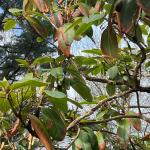 Pests/Problems: Yellow buttercup weed (Ranunculus ficaria) is in full bloom. Other weeds seen in bloom include dandelion (Taraxacum officinale) and purple deadnettle (Lamium purpurea). Norway maples (Acer platanoides) are also in full bloom with yellowish-green flowers all over the landscape (Norway maple is invasive). Winter injury was observed on some rhododendrons. The most common symptom of winter injury in rhododendrons/azaleas is leaves turning brown. Leaf tips or margins turn brown and branches may exhibit dieback. Injured leaves can be picked off and branches exhibiting dieback can be pruned off after spring growth begins to show.
Pests/Problems: Yellow buttercup weed (Ranunculus ficaria) is in full bloom. Other weeds seen in bloom include dandelion (Taraxacum officinale) and purple deadnettle (Lamium purpurea). Norway maples (Acer platanoides) are also in full bloom with yellowish-green flowers all over the landscape (Norway maple is invasive). Winter injury was observed on some rhododendrons. The most common symptom of winter injury in rhododendrons/azaleas is leaves turning brown. Leaf tips or margins turn brown and branches may exhibit dieback. Injured leaves can be picked off and branches exhibiting dieback can be pruned off after spring growth begins to show.
East Region (Boston)
General Conditions: The weather has been consistently cool and dry for late April. Daytime temperatures averaged 58ᣞF over the past week with a high of 64ᣞF on the 23rd. We did receive 0.22” of precipitation overnight on April 26th. Some notable plants in bloom include: Lamprocapnos spectabilis (bleeding heart), Epimedium x rubrum (red barrenwort), Chaenomeles speciosa (flowering quince), Kerria japonica (Japanese kerria), Leucojum aestivum (giant snowdrop), Prunus subhirtella (weeping higan cherry) and Viburnum carlesii (Korean spice viburnum). Recent weather conditions have extended the length of bloom time of the yellow magnolias; Magnolia ‘Butterflies’ and Magnolia ‘Elizabeth’ are looking especially nice. The lesser known and underutilized Paeonia japonica (woodland peony) is just beginning to flower.
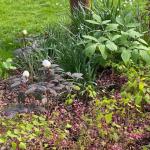
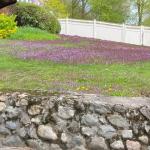 Pests/Problems: We have received only 2.83 inches of precipitation in April. Plantings in raised beds and containers are in need of supplemental irrigation. Many trees are in full bloom and lack of typical April showers is contributing to a higher than average pollen count. Turf weeds are outcompeting desirable grasses in many unmanaged lawns. Dandelion (Taraxacum officinalis), ground ivy (Glechoma hederacea) and lesser celandine (Ficaria verna) are in flower. Star of Bethlehem (Ornithogalum umbellatum) has clumping vegetative growth 3 times taller than most surrounding grasses. Other landscape weeds in flower include; common chickweed (Stellaria media), common shepherd's purse (Capsella bursa-pastoris), garlic mustard (Alliaria petiolata) and purple dead nettle (Lamium purpureum). Japanese knotweed (Polygonum cuspidatum) new shoots are up to a foot tall. There is still time to manually prune out the viburnum leaf beetle (Pyrrhalta viburni) egg deposits from the infested branch tips of susceptible viburnum.
Pests/Problems: We have received only 2.83 inches of precipitation in April. Plantings in raised beds and containers are in need of supplemental irrigation. Many trees are in full bloom and lack of typical April showers is contributing to a higher than average pollen count. Turf weeds are outcompeting desirable grasses in many unmanaged lawns. Dandelion (Taraxacum officinalis), ground ivy (Glechoma hederacea) and lesser celandine (Ficaria verna) are in flower. Star of Bethlehem (Ornithogalum umbellatum) has clumping vegetative growth 3 times taller than most surrounding grasses. Other landscape weeds in flower include; common chickweed (Stellaria media), common shepherd's purse (Capsella bursa-pastoris), garlic mustard (Alliaria petiolata) and purple dead nettle (Lamium purpureum). Japanese knotweed (Polygonum cuspidatum) new shoots are up to a foot tall. There is still time to manually prune out the viburnum leaf beetle (Pyrrhalta viburni) egg deposits from the infested branch tips of susceptible viburnum.
Metro West (Acton)
General Conditions: Happy Arbor Day! This year marks its 150th anniversary. The landscape is filled with activity and color including deer browsing on the tender new Syringa (lilac) shoots and leaves. Daytime temperatures are warming, and evening/early morning temperatures continue to fall below freezing. I woke to a thin layer of frost on my car windshield on the morning of the 21st. April showers have been less frequent this week. I reported last week that there was some amount of precipitation recorded on most days for the month of April. Now, a week later, only 0.38 of rain has been recorded and on two days only. The average rainfall total for the month of April is 4.16” and I have recorded a total of 3.33” of rain in this area for this month so far. In addition to those reported in the Phenology table above, woody plants seen in bloom this past week are Chaenomeles speciosa (common flowering quince), Magnolia x loebneri 'Merrill', (Merrill magnolia), M. 'Butterflies' (butterflies magnolia), M. 'Yellow Lantern’ (yellow lantern magnolia), Pieris japonica (Japanese pieris), Prunus serrulata 'Kwanzan' (kwanzan cherry), and Pyrus spp. (pear). Contributing even more color and interest to the landscape are some flowering herbaceous plants and spring ephemerals including: Anemone nemorosa (wood anemone), Asarum europaeum (European ginger), Caltha palustris (marsh marigold), Claytonia virginica (Virginia spring beauty), Lamprocapnos spectabilis (old fashioned bleeding heart), Hyacinthus spp. (hyacinth), Mertensia virginica (Virginia bluebells), Narcissus spp. (daffodil), Omphalodes verna (blue-eyed Mary), Pachysandra procumbens (Allegheny spurge), P. terminalis (Japanese pachysandra), Phlox subulata (moss phlox), Primula spp. (primrose), Pulmonaria longifolia (lungwort), P. rubra (salmon-colored lungwort), Sanguinaria canadensis (bloodroot), S. canadensis 'Multiplex' (double bloodroot), Vinca minor (periwinkle), and Viola spp. (violet).
Pests/Problems: Acer platanoides (Norway maple) is in full bloom. This invasive tree is hard to miss now that it is in bloom and its flowers are a bright yellowish-green and are easily seen on trees found growing almost everywhere. Many herbaceous weeds are in flower including one of the most invasive of all time, Alliaria petiolata (garlic mustard), which is just beginning to bloom and can easily be seen due to its white flowers and the fact that it is growing everywhere including on roadsides and in woodlands, wetlands and gardens. Other weeds seen in bloom now are Glechoma hederacea (ground ivy), Lamium purpureum (purple dead nettle) and Taraxacum officinale (dandelion). Weeds emerging but not in bloom include: Arctium minus (lesser burdock), Impatiens capensis (touch-me-not) and Polygonum cuspidatum (Japanese knotweed).
Central Region (Boylston)
General Conditions: It’s been a chilly and dry end to the month of April. High temperatures this reporting period were consistently in the mid-50’s, barely touching the low-60’s. Rainfall has been scarce and we are lower than average for monthly precipitation at just over 3 total inches in April. Fortunately, the cooler temperatures are prolonging blooms on a lot of early spring flowering ornamentals. Daffodils are going strong, the earliest tulips are starting to bloom, Muscari (grape hyacinths) look great and both Siberian squill (Scilla siberica) and glory-of-the-snow (Scilla luciliae) are still looking great. Magnolia x soulangeana (saucer magnolia) is at its peak bloom and M. ‘Elizabeth’ (yellow magnolia) is just starting to open. Overall, despite the cool air temperatures, spring is in its full glory.
Pests/Problems: Nothing notable. It is unseasonably dry, although not to the point of impacting plant health. Two common lawn weeds, dandelions (Taraxacum officinale) and ground ivy (Glechoma hederacea), are in bloom.
Pioneer Valley Region (Amherst)
General Conditions: April is wrapping up and May is on the horizon as spring chugs forward in the tri-counties. High temperatures over the past week ranged from the mid-50s to upper 60s with lows ranging from the low 30s to low 50s. There was patchy frost on the morning of 4/23 but no observable injury. We dried out a bit since our last report, with only 0.25–0.35” of precipitation on 4/26. With the increasing sun intensity, lack of foliage on deciduous trees, low humidity and determined spring winds, it doesn’t take long for the upper soil surface to dry out. That said, soils are still moist and this is prime time for new planting. There is still a risk of frost with forecasted lows near freezing (at the time of writing). Typically, in the valley lowlands, the threat of frost persists until mid-May. Many rosaceous trees and shrubs (crabapple, apple, serviceberry, hawthorn, quince, etc.) are leafing out, along with ginkgo, larch, viburnum and Japanese maple. Yellow (forsythia), pink (flowering cherry) and purple (PJM rhododendron) are dominating the landscape color palette. But closer inspection shows a range of different annuals, perennials and woodies pushing new growth and starting to flower. Arborvitae, juniper and false-cypress are actively growing and buds on spruce and hemlock are swelling. Pine candles are elongating and we will soon be in the peak period to observe white pine needle damage (late May to early June).
Pests/Problems: With apples and crabapples leafing out, apple scab season is upon us. In many cases, it’s not worthwhile to chemically treat for this ubiquitous foliar pathogen (Venturia inaequalis). Even regular fungicide application may do little to slow down the disease. But now is still a good time to prune with an eye towards disease management. Remove inner canopy suckers to improve air flow and light penetration into the canopy. If a branch or stem has foliage that is completely shaded, it should be removed. Not only will this practice aid in disease control but it will also dramatically improve the appearance of the tree. As a landscape ornamental, crabapple is arguably unrivaled in its combined floral and olfactory display (certainly a case to be made for lilacs, but that’s a shrub). Spotted lanternfly establishment is a major concern this season, so get to know the appearance of the egg masses and carefully inspect nursery stock, landscape stone and any other material that’s introduced to the landscape. See the Insects section below for further information. As American and European beech start leafing out, carefully scout for symptoms of beech leaf disease (BLD) caused by the foliar nematode Litylenchus crenatae ssp. mccannii. Report any suspected cases to the UMass Extension Plant Diagnostic Lab. The symptoms of BLD will be present on the leaves as they expand. Look for dark green, interveinal banding and convex blistering (when viewing the upper leaf surface). At present, BLD is not known to occur in Hampden, Hampshire and Franklin counties but will soon establish here. Symptoms present on this season’s leaves indicate infestations that occurred in 2021.
Berkshire Region (Great Barrington)
General Conditions: Day time temperatures continued to fluctuate over the past week from mild and sunny or partly sunny to cloudy and chilly. Frost occurred on the mornings of the 20th and 21st. Frost again is predicted for the mornings of the 28th and 29th. The one consistent weather occurrence continues to be the wind, which often makes it feel much colder than the actual air temperature. Plant development is behind that of last year at this time. Though most of the past week has been dry, precipitation for the month and year to-date is well above normal. According to data recorded at the Pittsfield Airport, precipitation year to date (4/27) is 13.29 inches compared to a norm of 11.21 inches. For the month of April thus far, precipitation is 4.28 inches compared to a norm of 2.94 inches. So, while this past week has been relatively dry and windy, soil moisture levels are quite good. This certainly favors planting of trees, shrubs, and hardy herbaceous plants as well as the seeding of lawns. Flowering of trees and shrubs is behind that of recent years but there is a steady progression of spring flowering bulbs. Daffodils (Narcissus spp.) continue to bloom with many cultivars just opening. Other bulbs coming into bloom now are hyacinths (Hyacinthus) and grape hyacinths (Muscari). Groundcovers beginning to flower are creeping myrtle (Vinca minor) and Japanese spurge or pachysandra (Pachysandra terminalis). Though not officially categorized as invasive in Massachusetts (https://www.massnrc.org/mipag/linvasive.htm), P. terminalis can spread aggressively. A good alternative groundcover is native Allegheny spurge (Pachysandra procumbens) which tends to be less aggressive. All in all, spring has been progressing more slowly than we have become used to.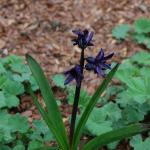
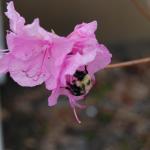
Pests/Problems: Pest and disease problems are few at this time. The most commonly observed problems relate to “winter burn” or desiccation. This has been observed on rhododendrons and needled evergreens, especially (Picea glauca var. albertiana) 'Alberta Globe' white spruce. Weed development has picked up the pace. With soils still moist, weeding is easier at this time than it will be as soils become drier. As winds persist, so does damage to trees. Boxwood leafminer is currently in the larval stage and feeding within the leaves of boxwood. The frequency of deer tick attachment to those working in the landscape has increased. Vole tunneling and trails are common in many lawns and in ornamental gardens.
Regional Scouting Credits
- CAPE COD REGION - Russell Norton, Horticulture and Agriculture Educator with Cape Cod Cooperative Extension, reporting from Barnstable.
- SOUTHEAST REGION - Brian McMahon, Arborist, reporting from the Dighton area.
- NORTH SHORE REGION - Geoffrey Njue, Green Industry Specialist, UMass Extension, reporting from the Long Hill Reservation, Beverly.
- EAST REGION - Kit Ganshaw & Sue Pfeiffer, Horticulturists reporting from the Boston area.
- METRO WEST REGION – Julie Coop, Forester, Massachusetts Department of Conservation & Recreation, reporting from Acton.
- CENTRAL REGION - Mark Richardson, Director of Horticulture reporting from New England Botanic Garden at Tower Hill, Boylston.
- PIONEER VALLEY REGION - Nick Brazee, Plant Pathologist, UMass Extension Plant Diagnostic Lab, reporting from Amherst.
- BERKSHIRE REGION - Ron Kujawski, Horticultural Consultant, reporting from Great Barrington.
Woody Ornamentals
Diseases
Recent pests and pathogens of interest seen in the UMass Extension Plant Diagnostic Lab, a select few. http://ag.umass.edu/diagnostics
- Lower canopy dieback of blue spruce (Picea pungens) caused by Stigmina lautii and Rhizosphaera kalkhoffii. A row of approximately 30-year-old trees growing in a shaded setting with compacted, poorly-drained soils on a slope. Needle blight on blue spruce is a chronic issue that destroys the tree’s aesthetic value. Badly infected trees have a thin appearance in the lower canopy with an abundance of dead interior stems and branches. Stigmina can be found sporulating on green needles while Rhizosphaera often sporulates from dead needles that are purple to brown in color. There was no evidence of the spruce spider mite, armored scales or stem cankering pathogens from the submitted sample.
- Needle browning and shoot tip dieback of Bar Harbor creeping juniper (Juniperus horizontalis ‘Bar Harbor’) due to meadow vole (Microtus pennsylvanicus) feeding and infection by Pestalotiopsis. The plants are approximately 10-years-old and have been present at the site for seven years. They receive full afternoon sun with drip irrigation in a well-drained, sandy loam soil. The submitted sample had evidence of rodent chewing at the shoot tips along with blighted shoots and needles that were pale green to brown, harboring the fungal pathogen. When afforded protective snow cover, voles can do serious damage to creeping junipers. While not a preferred food source, juniper needles can be browsed when resources become scarce over the winter months. It’s difficult to confirm the presence of voles based on the tunnel exit holes alone. Short-tailed shrews may be present, especially if the landscape borders a natural woodland.
- Nectria canker, caused by Nectria cinnabarina, on Japanese snowbell (Styrax japonica). The tree is roughly 15-years-old and resides on the UMass campus. It was planted 10 years ago and receives full sun for most of the day. The loam-based soils are compacted and poorly drained and the tree was planted high to account for the poor drainage. For many years now (at least five), Nectria canker has plagued this tree, resulting in a progressively worsening stem and branch dieback. Pruning to remove the blighted stems and branches has left the tree disfigured. A large canker developed on the main stem and was subsequently colonized by an unknown decay fungus. The tree is producing ample wound wood around the pruning sites but also a proliferation of shoots that could serve as new infection sites.
- Cryptocline needle blight (Cryptocline taxicola) on English yew (Taxus baccata). An isolated area of a 100’ long hedge, approximately 50-years-old, has been showing symptoms of dieback. Specifically, the needles are dark brown and stunted, but the damage has spread slowly over the past two years. Yew needles infected by C. taxicola appear dark brown to black in color and may prematurely shed from the canopy. Conversely, in some cases they do not abscise and are held long after they are dead. The pathogen is widespread but the disease is not common. However, it does have the potential to cause major damage on stressed and weakened yews, which have relatively few associated pathogens.
Report by Nick Brazee, Plant Pathologist, UMass Extension Plant Diagnostic Lab, UMass Amherst.
Insects
An Update about Neonicotinoid Use in Massachusetts:
Beginning July 1, 2022 systemic insecticide active ingredients known as neonicotinoids will become state restricted use for tree and shrub uses in Massachusetts. If an individual works in the commercial industry (landscapers, arborists, etc.), then a Commercial Certification License is needed. (Example: Category 36 Commercial Certification License, Shade Trees & Ornamentals.) Someone can use a state or federal restricted use pesticide if they have a Commercial Applicators License as long as they are working under the direct supervision of someone with a Commercial Certification. Unlicensed or uncertified individuals will no longer be able to apply neonicotinoids to manage insect pests of trees and shrubs in Massachusetts.
More information is available, here: https://www.mass.gov/service-details/pesticide-newsupdates
Interesting Insects Reported Recently:
-
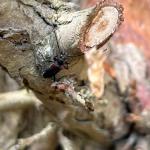
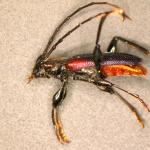 Japanese Cedar Longhorned Beetle: Callidiellum rufipenne is an insect native to Asia that was first detected in Vancouver, BC, in 1927 and in Connecticut in the 1990’s. It is now known in parts of New England, New York, and the eastern US. It has been previously reported in Suffolk County, MA and was recently reported in Nantucket County, MA on 4/21/2022 by Dr. Kevin Chase, Entomologist, and Megan McConnell, Diagnostic Services Manager, following detection by Jim Cook, Arborist.
Japanese Cedar Longhorned Beetle: Callidiellum rufipenne is an insect native to Asia that was first detected in Vancouver, BC, in 1927 and in Connecticut in the 1990’s. It is now known in parts of New England, New York, and the eastern US. It has been previously reported in Suffolk County, MA and was recently reported in Nantucket County, MA on 4/21/2022 by Dr. Kevin Chase, Entomologist, and Megan McConnell, Diagnostic Services Manager, following detection by Jim Cook, Arborist.
This wood boring beetle is found in conifers belonging to the cypress family. Primary hosts noted for this species include arborvitae, cypress, juniper, and cedar (Chamaecyparis). Adult beetles are small, approximately ¼ to ½ inch in length with long antennae. The females have reddish brown elytra (hardened wings) and the males appear darker in color with red visible on the “shoulders” of the beetle (just behind the thorax). There is one generation per year. Once the females emerge from their host, they begin to lay eggs in the cracks and crevices of bark. Eggs hatch and the larvae bore beneath the bark, creating tunnels or galleries as they feed in the phloem and cambium layers of the tree. Larvae are cream colored with 3 pairs of thoracic legs and grow up to approximately ¾ inch in length. When the larvae are mature, they enter the xylem where they pupate. The Japanese cedar longhorned beetle is thought to overwinter as an adult within the host plant, and emerges early the next season in the spring (Hoebeke, 1999). The feeding damage from the larvae of this insect causes branch dieback which may not be noticed until the following spring after initial infestation. Other signs of this insect include frass found near galleries and splits in the bark and 1/8 inch exit holes. Borers may be preferentially attracted to stressed plants.
Insects and Other Arthropods
-
Deer Tick/Blacklegged Tick: Ixodes scapularis adults have been active all winter, as they typically are from October through May, and “quest” or search for hosts at any point when daytime temperatures are above freezing. Engorged females survive the winter and will lay 1,500+ eggs in the forest leaf litter beginning around Memorial Day (late May). For images of all deer tick life stages, along with an outline of the diseases they carry, visit: https://web.uri.edu/tickencounter/species/blacklegged-tick/ .
Anyone working in the yard and garden on springtime cleanup and planting should be aware that there is the potential to encounter deer ticks. The deer tick or blacklegged tick can transmit Lyme disease, human babesiosis, human anaplasmosis, and other diseases. Preventative activities, such as daily tick checks, wearing appropriate clothing, and permethrin treatments for clothing (according to label instructions) can aid in reducing the risk that a tick will become attached to your body. If a tick cannot attach and feed, it will not transmit disease. For more information about personal protective measures, visit: https://web.uri.edu/tickencounter/prevention/protect-yourself/
The Center for Agriculture, Food, and the Environment provides a list of potential tick identification and testing resources here: https://ag.umass.edu/resources/tick-testing-resources .
Woody ornamental insect and non-insect arthropod pests to consider, a selected few:
Invasive Insects & Other Organisms Update:
-
Spongy Moth: Lymantria dispar egg masses will soon be hatching, roughly between 90 -100 growing degree days (roughly the first week in May, but this varies). They may be found, after overwintering, on just about any flat surface, including host plants such as oak, but also fencing, buildings, steps, outdoor furniture, and more. Scout properties, particularly in areas of Berkshire County, MA that experienced elevated L. dispar populations in 2021. If large numbers of egg masses are seen, monitor them now and in the coming weeks to better time egg hatch and caterpillar emergence. If egg masses are plentiful near high-value specimen trees in Berkshire County this year, consider applying the reduced risk insecticide Bacillus thuringiensis Kurstaki (Btk) to host plant leaves before caterpillars are over ¾ inch in length.
Why did the common name for Lymantria dispar change recently? More information is available here: https://entsoc.org/news/press-releases/spongy-moth-approved-new-common-name-lymantria-dispar .
-
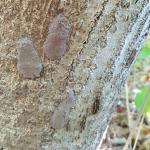 Spotted Lanternfly: (Lycorma delicatula, SLF) is a non-native, invasive insect that feeds on over 103 species of plants, including many trees and shrubs that are important in our landscapes. It overwinters as an egg mass, which the adult female insect lays on just about any flat surface. Pictures of egg masses can be seen here: https://massnrc.org/pests/linkeddocuments/SLFChecklistForResidents.pdf .
Spotted Lanternfly: (Lycorma delicatula, SLF) is a non-native, invasive insect that feeds on over 103 species of plants, including many trees and shrubs that are important in our landscapes. It overwinters as an egg mass, which the adult female insect lays on just about any flat surface. Pictures of egg masses can be seen here: https://massnrc.org/pests/linkeddocuments/SLFChecklistForResidents.pdf .
The MA Department of Agricultural Resources (MDAR) recently released the following “Notice to Nursery and Landscape Industry” regarding spotted lanternfly, an excerpt of which is included here:
Last year, the Massachusetts Department of Agricultural Resources (“MDAR”) detected populations of the invasive pest known as spotted lanternfly (Lycorma delicatula) in multiple locations throughout the state. Since this is the time of year that nurseries are receiving shipments of stock for the spring planting season, we are sending this notice to remind growers and landscapers to inspect any plant material coming from states where SLF has been found, to ensure it does not harbor SLF egg masses, and to report any finds to MDAR. This reminder is especially important as MDAR has recently received several reports that nursery stock from SLF-infested areas was sent to Massachusetts growers.
To read the FULL NOTICE, visit: https://massnrc.org/pests/blog/?p=2933 .
Currently, the only established populations of spotted lanternfly in Massachusetts are in a small area in both Fitchburg and Shrewsbury, MA. Therefore, there is no reason to be preemptively treating for this insect in other areas of Massachusetts. If you suspect you have found spotted lanternfly in additional locations, please report it immediately to MDAR here: https://massnrc.org/pests/slfreport.aspx . If you are living and working in the Fitchburg and Shrewsbury areas, please be vigilant and continue to report anything suspicious.
For More Information:
From UMass Extension:
Check out the InsectXaminer Episode about spotted lanternfly adults and egg masses! Available here: https://ag.umass.edu/landscape/education-events/insectxaminer
Fact Sheet: https://ag.umass.edu/landscape/fact-sheets/spotted-lanternfly
From the MA Department of Agricultural Resources:
Fact Sheet and Map of Locations in MA: https://massnrc.org/pests/pestFAQsheets/spottedlanternfly.html
-
Asian Longhorned Beetle: (Anoplophora glabripennis, ALB) Look for signs of an ALB infestation which include perfectly round exit holes (about the size of a dime), shallow oval or round scars in the bark where a female has chewed an egg site, or sawdust-like frass (excrement) on the ground nearby host trees or caught in between branches. Be advised that other, native insects may create perfectly round exit holes or sawdust-like frass, which can be confused with signs of ALB activity.
The regulated area for Asian longhorned beetle is 110 square miles encompassing Worcester, Shrewsbury, Boylston, West Boylston, and parts of Holden and Auburn. If you believe you have seen damage caused by this insect, such as exit holes or egg sites, on susceptible host trees like maple, please call the Asian Longhorned Beetle Eradication Program office in Worcester, MA at 508-852-8090 or toll free at 1-866-702-9938.
To report an Asian longhorned beetle find online or compare it to common insect look-alikes, visit: http://massnrc.org/pests/albreport.aspx or https://www.aphis.usda.gov/pests-diseases/alb/report .
-
Browntail Moth: Euproctis chrysorrhoea is an invasive insect originating from Europe and first detected in the US in Somerville, MA in 1897. Currently, browntail moth is limited to a small portion of eastern Massachusetts, particularly areas near the coast. Scout for the tightly wrapped winter webs which have overwintering caterpillars within by looking at the tips of host plant branches. Report suspected browntail moth webs here: https://massnrc.org/pests/pestreports.htm . Due to a persistent outbreak of this insect in Maine since approximately 2016, it is a good idea for us to again familiarize ourselves with this pest. (For more information and the latest updates about the status of this insect in Maine, visit: https://www.maine.gov/dacf/mfs/forest_health/invasive_threats/browntail_moth_info.htm .)
Caution: hairs found on the caterpillar and pupal life stages of this insect can cause a rash similar to poison ivy. Some individuals are very sensitive to browntail moth hairs and may also experience allergic reaction. The chance of interacting with browntail moth hairs increases between May and July, although they could be a problem at any time of year.
The larval or caterpillar stage of this insect is present from August until the following June (spending the winter in webs they create on the tips of host plant twigs). In the fall, groups of caterpillars are found creating webs around a tightly wrapped leaf (covered in bright white silk) where they will overwinter in groups of 25-400. These 2-4 inch long webs can be found on the ends of branches often on apple or red oak. As soon as leaves begin to open in the spring (usually by April), the caterpillars will crawl from their webs to feed on the new leaves. Caterpillars are fully grown around June and spin cocoons in which they pupate. These cocoons are also full of the irritating hairs and should be dealt with extreme caution. Adult moths emerge in July and females lay eggs on the undersides of leaves in masses of 200-400, covering them with hairs from their bodies. (Adults do not typically cause skin rashes.) Eggs hatch around August and September and larvae feed shortly before forming their overwintering webs.
The primary concern with this insect are the poisonous hairs found on the caterpillars. Contact with the caterpillar or its hairs can cause a rash similar to poison ivy in susceptible individuals. If hairs break off and blow around in the wind, they can cause difficulty breathing and headaches. While this insect can act as a defoliator in the larval stage, feeding on the leaves of many deciduous trees and shrubs, this activity may be secondary to concerns about public health risks. Care should be taken to avoid places infested with these caterpillars, exposed skin or clothing should be washed, and the appropriate PPE should be worn if working with these insects. Consult your physician if you have a reaction to the browntail moth.
-
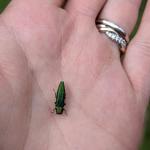 Emerald Ash Borer: (Agrilus planipennis, EAB) has been detected in at least 11 out of the 14 counties in Massachusetts. A map of these locations across the state may be found here: https://ag.umass.edu/fact-sheets/emerald-ash-borer . Additional information about this insect is provided by the MA Department of Conservation and Recreation, here: https://storymaps.arcgis.com/stories/b60f63199fa14805a8b9f7c82447a25b .
Emerald Ash Borer: (Agrilus planipennis, EAB) has been detected in at least 11 out of the 14 counties in Massachusetts. A map of these locations across the state may be found here: https://ag.umass.edu/fact-sheets/emerald-ash-borer . Additional information about this insect is provided by the MA Department of Conservation and Recreation, here: https://storymaps.arcgis.com/stories/b60f63199fa14805a8b9f7c82447a25b .
This wood-boring beetle readily attacks ash (Fraxinus spp.) including white, green, and black ash and has also been found developing in white fringe tree (Chionanthus virginicus) and has been reported in cultivated olive (Olea europaea). Signs of an EAB infested tree may include D-shaped exit holes in the bark (from adult emergence), “blonding” or lighter coloration of the ash bark from woodpecker feeding (chipping away of the bark as they search for larvae beneath), and serpentine galleries visible through splits in the bark, from larval feeding beneath. It is interesting to note that woodpeckers are capable of eating 30-95% of the emerald ash borer larvae found in a single tree (Murphy et al. 2018). Unfortunately, despite high predation rates, EAB populations continue to grow. However, there is hope that biological control efforts will eventually catch up with the emerald ash borer population and preserve some of our native ash tree species for the future. For an update about the progress of the biological control of emerald ash borer, visit Dr. Joseph Elkinton’s archived 2022 webinar.
.
-
Winter Moth: (Operophtera brumata) data since 2017 has indicated that the winter moth population in eastern Massachusetts has been on the decline while the percent of winter moth pupae parasitized by Cyzenis albicans has increased! Dr. Joseph Elkinton’s laboratory at UMass Amherst has released this biological control of winter moth since 2005 and conducted the rigorous sampling required to determine where the insect has established and what its impact on the winter moth population has been at multiple sites in eastern MA. More information about the Elkinton Lab’s research and the biological control of winter moth can be found here: https://www.fs.fed.us/foresthealth/technology/pdfs/FHAAST-2018-03_Biology_Control_Winter-Moth.pdf .
The take-home point? Do not worry about winter moth this spring! In fact, management of this insect in landscaped settings will likely not be necessary in most locations. Blueberry and apple growers may still, on the other hand, be interested in scouting and continuing to monitor for this insect, as only very low numbers of winter moth caterpillars might be tolerated in those systems. For an April 16, 2022 update about winter moth in blueberry and apple production from Heather Faubert, University of Rhode Island, visit: https://web.uri.edu/ipm/2022/04/2667/ .
In recent years, it is worthwhile to note that some areas on the Cape and other locations in eastern MA have reported noticeable cankerworm populations in the spring, which are often confused for winter moth. Read more about cankerworms in the spring scouting list below.
-
Jumping Worms: Amynthas spp. earthworms, collectively referred to as “jumping or crazy or snake” worms, overwinter as eggs in tiny, mustard-seed sized cocoons found in the soil or other substrate (ex. compost). The tiny, impossible to remove cocoons will overwinter and provide a population of these earthworms in the 2022 season.
For More Information:
UMass Extension Fact Sheets:
Earthworms in Massachusetts – History, Concerns, and Benefits: https://ag.umass.edu/landscape/fact-sheets/earthworms-in-massachusetts-history-concerns-benefits
Jumping/Crazy/Snake Worms – Amynthas spp.:
https://ag.umass.edu/landscape/fact-sheets/jumpingcrazysnake-worms-amynthas-spp
A Summary of the Information Shared at UMass Extension’s Jumping Worm Conference in January 2022:
https://ag.umass.edu/news-events/highlights/jumping-worms-conference
Spring Scouting Suggestions & Preparation for Upcoming Tree & Shrub Insects:
-
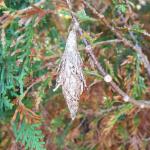 Bagworm: Thyridopteryx ephemeraeformis is a native species of moth whose larvae construct bag-like coverings over themselves with host plant leaves and twigs. This insect overwinters in the egg stage, within the bags of deceased females from last season. Eggs may hatch and young larvae are observed feeding around mid-June, or roughly between 600-900 GDD’s. Now is the time to scout for and remove and destroy overwintering bags. More information can be found here: https://ag.umass.edu/landscape/fact-sheets/bagworm
Bagworm: Thyridopteryx ephemeraeformis is a native species of moth whose larvae construct bag-like coverings over themselves with host plant leaves and twigs. This insect overwinters in the egg stage, within the bags of deceased females from last season. Eggs may hatch and young larvae are observed feeding around mid-June, or roughly between 600-900 GDD’s. Now is the time to scout for and remove and destroy overwintering bags. More information can be found here: https://ag.umass.edu/landscape/fact-sheets/bagworm -
Balsam Twig Aphid: Mindarus abietinus overwinters as a silvery colored egg on host plant twigs. Eggs hatch just prior to budbreak and nymphs feed for a period of time on the undersides of last season’s needles before molting into a wingless stem mother. Stem mothers move to buds just as they open and give “live birth” to second generation nymphs. These second generation nymphs are the most damaging, feeding on new needles as they elongate, causing distortion and stunting. Excessive amounts of honeydew may be produced and cause needles to stick together. Foliar applications, if needed, may be made between 30-100 GDD’s, base 50°F on warm days before budcaps loosen. Inspect the twigs, near the base of needles of Balsam fir, Fraser fir, and other true firs for overwintering eggs and eventually the needles for feeding nymphs. This insect may be most problematic in Christmas tree production. In landscapes, many natural enemies can provide adequate management of this insect.
-
Black Turpentine Beetle: Dendroctonus terebrans adults may begin to be active between mid-April to mid-May. Host plants include: black pine (Pinus thunbergiana), eastern white pine (Pinus strobus), Japanese black pine (Pinus thunbergii), loblolly pine (Pinus taeda), pitch pine (Pinus rigida), red spruce (Picea rubens), Scots pine (Pinus sylvestris), and slash pine (Pinus elliottii).
This is one of the largest native North American bark beetles. In the northern parts of its extensive range, the black turpentine beetle overwinters as an adult in the bark of its hosts. In the southern portions of its range, all life stages may be present throughout the year. Egg laying and feeding is usually kept to the basal 6 feet of the host plant. Mated pairs of adult beetles work to excavate galleries that may be 9.8 inches wide and 11.8 inches long. 100-200 eggs may be laid on one side of the gallery. Once hatched, larvae feed in groups on the inner bark. Fully grown larvae are legless, white, and almost 1/2 inch in length. Pupation occurs and adults eventually emerge from the bark to re-infest the same tree, or disperse to another susceptible host.
Stumps and buttress roots of freshly cut trees are favored by this insect. Attacked trees may exhibit browning of needles and oozing of large masses of pitch. Masses of pitch (pitch tubes) may cover holes in the trunk and may be considerably larger than those of southern pine beetle. Pitch hardens and is first white but may turn red as it ages. Pitch is irregular in shape and up to 1.6 inches in diameter. Pitch tubes are not visible when the area below the soil line is attacked. Healthy trees are usually not attacked, however it has been reported on occasion.
Check drought-stressed or otherwise stressed trees for needles turning light green to rust color. Check the lower 6 feet, particularly the lower 18 inches of the trunk for 1.6 inch in diameter pitch tubes or small entrance holes from the adults. Reddish-brown boring dust may be found near the base of the tree as well.
-
Boxwood Leafminer: Monarthropalpus flavus partly grown fly larvae overwinter in the leaves of susceptible boxwood. Yellowish mines may be noticeable on the undersides of leaves. This insect grows rapidly in the spring, transforming into an orange-colored pupa. After pupation, adults will emerge and white colored pupal cases may hang down from the underside of leaves where adults have emerged. Adults may be observed swarming hosts between 300-650 GDD’s, or roughly the end of May through June. Most cultivars of Buxus sempervirens and B. microphylla are thought to be susceptible. If installing new boxwoods this spring, resistant cultivars such as ‘Vardar Valley’ and ‘Handsworthiensis’ are good choices at sites where this insect has been a problem.
-
Boxwood Mite: Eurytetranychus buxi overwinter as tiny eggs on boxwood leaves and hatch mid-spring. These mites are tiny (about the size of a period) and difficult to detect. Feeding may cause plants to appear off-color. If management is deemed necessary, the timing for treatment may be between 245-600 GDD’s.
-
Boxwood Psyllid: Psylla buxi feeding can cause cupping of susceptible boxwood leaves. Leaf symptoms/damage may remain on plants for up to two years. English boxwood may be less severely impacted by this pest. Eggs overwinter, buried in budscales, and hatch around budbreak of boxwood. Eggs may hatch around 80 GDD’s. While foliar applications may be made between 290-440 GDD’s, the damage caused by this insect is mostly aesthetic. Therefore, typically, management is not necessary.
-
Cankerworms: Alsophila pometaria (fall cankerworm) and Paleacrita vernata (spring cankerworm) are often confused for winter moth (Operophtera brumata). Cankerworm populations in eastern MA, particularly on areas of Cape Cod, were confused for winter moth in 2019. Spring cankerworm adults are active in February and March, and fall cankerworm adults are active in late November into early December. During these times, both species lay eggs. These native insects most commonly utilize elm, apple, oak, linden, and beech. Eggs of both species hatch as soon as buds begin to open in the spring. Caterpillars occur in mixed populations and are often noticeable by mid-May in MA. Young larvae will feed on buds and unfolding leaves. There are two color forms (light green and dark) for caterpillars of both species. Like winter moth, they will drop to the soil to pupate. This usually occurs in June. Fall cankerworm larvae have three pairs of prolegs (one of which is small so it is sometimes referred to as ½) and spring cankerworm have two pairs. (Winter moth caterpillars also have 2 pairs of prolegs.) If populations are large and damage is noticeable on hosts, reduced risk insecticides such as Bacillus thuringiensis Kurstaki or spinosad may target larvae between approximately 148-290 GDD’s.
-
Cooley Spruce Gall Adelgid: Adelges cooleyi is a native insect that has a complex life cycle. It has at least five different morphological forms, and requires 2 years and two hosts to complete its normal life cycle. Galls (pineapple shaped/cone-like and at the tips of twigs) are produced on Colorado blue spruce, Engelmann, Sitka, and Oriental spruce and cause needle injury (yellow spots and distortion) to Douglas-fir. Immature females overwinter on spruce near twig terminals. In the early spring, females mature into stem mothers and lay hundreds of eggs on lateral terminals. Upon egg hatch, nymphs migrate to new spring growth and feed at the base of growing needles. Immatures can be targeted on spruce between 22-81 GDD’s (mid-late April). On Douglas-fir, dormant oil applications should be made immediately before budbreak to avoid phytotoxicity. Follow all label instructions.
-
Dogwood Borer: Synanthedon scitula is a species of clearwing moth whose larvae bore not only into dogwood (Cornus), but hosts also include flowering cherry, chestnut, apple, mountain ash, hickory, pecan, willow, birch, bayberry, oak, hazel, myrtle, and others. Kousa dogwood appear to be resistant to this species. Signs include the sloughing of loose bark, brown frass, particularly near bark cracks and wounds, dead branches, and adventitious growth. The timing of adult emergence can be expected when dogwood flower petals are dropping and weigela begins to bloom. Adult moth flights continue from then until September. Emergence in some hosts (ex. apple) appears to be delayed, but this differs depending upon the location in this insect’s range. Eggs are laid singly, or in small groups, on smooth and rough bark. Female moths preferentially lay eggs near wounded bark. After hatch, larvae wander until they find a suitable entrance point into the bark. This includes wounds, scars, or branch crotches. This insect may also be found in twig galls caused by other insects or fungi. Larvae feed on phloem and cambium. Fully grown larvae are white with a light brown head and are approx. ½ inch long. Pheromone traps and lures are useful for determining the timing of adult moth emergence and subsequent management.
-
Dogwood Sawfly: Macremphytus tarsatus has one generation per year. The larvae of the dogwood sawfly overwinter in decaying wood and occasionally compromised structural timber. An overwintering "cell" is created in this soft wood. Pupation occurs in the springtime and adults can take a lengthy time to emerge, roughly between late May and July. 100+ eggs are laid in groups on the underside of leaves. Eggs hatch and the larvae feed gregariously, initially skeletonizing leaves. As the caterpillars grow in size, they are capable of eating the entire leaf with the exception of the midvein. Larval appearance varies greatly throughout instars, so much so that one might mistake them for multiple species. Early instars are translucent and yellow, but as the caterpillars grow they develop black spots (over yellow) and become covered in a white powder-like material. Larvae and their shed skins may resemble bird droppings. Full grown larvae begin to wander in search of a suitable overwintering location. Rotting wood lying on the ground is preferred for this. Foliage of dogwood, especially gray dogwood (Cornus racemosa) may be impacted. Skeletonizes leaves at first, then eats all but the midvein.
-
Eastern Spruce Gall Adelgid: Adelges abietis is a pest of Norway spruce primarily, but occasionally damages other spruce species such as Colorado blue, white, and red spruce. This adelgid overwinters as a partially grown female, often referred to as a stem mother. This overwintering individual matures around bud break and lays 100-200 eggs. The eastern spruce gall adelgid may be targeted for management between 22-170 GDD’s, base 50°F (mid-April to early-May). This insect is non-native, and was introduced into the United States from Europe before 1900. Galls are small, sometimes pineapple shaped/variable, but produced on the basal portion of the shoots, such that the twig extends beyond the gall. Twig dieback may occur.
-
Eastern Tent Caterpillar: Malacosoma americanum eggs overwinter on host plant twigs. Egg hatch typically occurs when wild cherry leaves begin to unfold and young caterpillars may emerge by late-April through the first two weeks in May (90-190 GDD’s). Susceptible hosts include cherry and crabapple. Other host plants whose leaves are fed upon by this native insect can include apple, ash, birch, willow, maple, oak, poplar, and witch-hazel. Prune off and remove egg masses from ornamental host plants by early spring. Eastern tent caterpillars are native to Massachusetts and have many associated natural enemies (parasites and predators) that help regulate populations. Unless these caterpillars are actively defoliating specimen trees in a landscaped setting, we can coexist with this particular herbivore native to our forests.
-
Elm Leaf Beetle: Xanthogaleruca (formerly Pyrrhalta) luteola is found on American elm (Ulmus americana; not preferred), Chinese Elm (Ulmus parvifolia; not preferred), English Elm (Ulmus procera; preferred host), Japanese Zelkova (Zelkova serrata), and Siberian Elm (Ulmus pumila; preferred host).
This species was accidentally introduced into the eastern United States early in the 1800's. Since then, it has been found throughout the USA anywhere elms are located. It also occurs in eastern Canada. The adult elm leaf beetle overwinters in protected areas, such as the loose bark of trees, but can also be a nuisance when it tries to invade homes in search of overwintering protection. Beetles will try to enter houses or sheds in the fall.
In the spring, the adult beetles will fly back to the host plant and chew small, semi-circular holes in the leaves. The adult female can lay 600-800 yellow eggs in her life. Eggs are laid in clusters on the leaves and resemble pointy footballs. Larvae are tiny, black, and grub-like when they hatch from the egg. Young larvae will skeletonize the undersides of leaves. As they grow in size, the larvae become yellow-green with rows of black projections. Oldest larvae may appear to have two black stripes along their sides, made from the black projections. There are 3 larval instars. Mature larvae will wander down the trunk of the host tree and pupate in the open on the ground at the tree base or in cracks and crevices in the trunk or larger limbs. They spend approximately 10 or so days as a pupa, and then the adults emerge. Those adults will fly to the foliage of the same host plant or other adjacent potential hosts in the area, where they will lay eggs. In the fall, the adults will leave the host plant in search of overwintering shelter. In most locations in the USA, two generations of this insect are possible per year. In warmer locations, 3-4 generations per year are possible.
Leaves are skeletonized by the larvae. Skeletonization may cause the leaf to turn brown or whitish. Adults are capable of chewing through the leaf, often in a shothole pattern. When in very large populations, they are capable of completely defoliating plants. Populations of this insect can fluctuate from year to year, and often management is not necessary if populations are low. However, defoliation for consecutive seasons may lead to branch dieback or death of the entire tree.
-
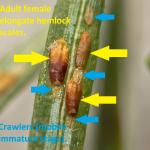 Elongate Hemlock Scale: Fiorinia externa is found on eastern, Carolina, and Japanese hemlock, as well as yew, spruce, and fir. The elongate hemlock scale may overwinter in various life stages and overlap of many developmental stages at any given time can be observed throughout much of the season. Dormant oil applications for this pest can occur according to label instructions in April, roughly between 7-120 GDD’s. Treatments for the crawler, or mobile, stage of this insect may be made in late May through mid-June, or between 360-700 GDD’s, base 50°F. Nitrogen fertilizer applications may make elongate hemlock scale infestations worse.
Elongate Hemlock Scale: Fiorinia externa is found on eastern, Carolina, and Japanese hemlock, as well as yew, spruce, and fir. The elongate hemlock scale may overwinter in various life stages and overlap of many developmental stages at any given time can be observed throughout much of the season. Dormant oil applications for this pest can occur according to label instructions in April, roughly between 7-120 GDD’s. Treatments for the crawler, or mobile, stage of this insect may be made in late May through mid-June, or between 360-700 GDD’s, base 50°F. Nitrogen fertilizer applications may make elongate hemlock scale infestations worse. -
Euonymus Scale: Unaspis euonymi is an armored scale that can be found on euonymus, holly, bittersweet, and pachysandra. This insect can cause yellow spotting on leaves, dieback, and distorted bark. Dormant oil applications can be made between 35-120 GDD’s or roughly from mid-April to early-May. For crawlers, early June timing is suggested between 533-820 GDD’s. (Eggs begin to hatch in early June.)
-
European Pine Sawfly: Neodiprion sertifer overwinters in the egg stage. Eggs are laid by females the previous season by cutting slits in needles using their ovipositors and depositing 6-8 eggs in each of 10-12 needles. Egg hatch occurs from late-April to mid-May and caterpillars become active roughly between 78-220 GDD, base 50°F. The primary host in MA is Mugo pine but it can be found on Scots, red, jack, and Japanese red pine. It is also found on white, Austrian, ponderosa, shortleaf, and pitch pine when planted near the aforementioned species. This dark colored caterpillar feeds in tight groups and small numbers can be pruned or plucked out of host plants and destroyed. Spinosad products can be used whenever the caterpillars are actively feeding, usually by mid-May and when caterpillars are still small. Bacillus thuringiensis kurstaki is not effective against sawflies.
-
Fletcher Scale: Parthenolecanium fletcheri is a soft scale pest of yew, juniper, and arborvitae. Feeding scales, especially on yew, result in honeydew and sooty mold, needle yellowing, and at times, premature needle drop. There is one generation per year. Overwintered second instar nymphs can be targeted between 38-148 GDD’s, base 50°F. Nymphs develop and adult females lay eggs (on average 500-600) in May that hatch by June. Dead females conceal egg masses beneath. Crawlers migrate short distances to branches and may be concentrated on certain branches of a particular plant.
-
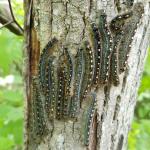 Forest Tent Caterpillar: Malacosoma disstria egg hatch occurs between 192-363 GDD’s, base 50°F, by mid-late May and caterpillars may be active for at least 5-6 weeks following. Susceptible hosts whose leaves are fed on by this insect include oak, birch, ash, maple, elm, poplar, and basswood. This native insect has many natural enemies, including some very effective pathogens that typically regulate populations. However, outbreaks of this insect can occur on occasion.
Forest Tent Caterpillar: Malacosoma disstria egg hatch occurs between 192-363 GDD’s, base 50°F, by mid-late May and caterpillars may be active for at least 5-6 weeks following. Susceptible hosts whose leaves are fed on by this insect include oak, birch, ash, maple, elm, poplar, and basswood. This native insect has many natural enemies, including some very effective pathogens that typically regulate populations. However, outbreaks of this insect can occur on occasion. -
Hemlock Looper: Two species of geometrid moths in the genus Lambdina are native insects capable of defoliating eastern hemlock, balsam fir, and white spruce. Adult moths lay their eggs on the trunk and limbs of hosts in September and October, and eggs will hatch by late May or early June. (L. fiscellaria caterpillars may be active between 448-707 GDD’s.) Monitor susceptible hosts for small, inch-worm like caterpillars. Where populations are low, no management is necessary. Hemlock loopers have several effective natural enemies.
-
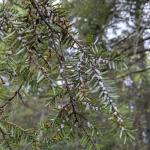 Hemlock Woolly Adelgid: Adelges tsugae is present on eastern and Carolina hemlock. The overwintering hemlock woolly adelgid generation (sistens) is present through mid-spring and produces the spring generation (progrediens) which will be present from early spring through mid-summer. HWA, unlike many other insects, does most of its feeding over the winter. Eggs may be found in woolly masses at the base of hemlock needles beginning in mid-March. Each woolly mass is created by a female who may then lay 50-300 eggs. Hemlock woolly adelgid eggs were observed in samples collected in Amherst, MA on April 13, 2022. Eggs hatch and crawlers may be found from mid-March through mid-July. Infested trees may be treated with foliar sprays in late April to early May, using Japanese quince as a phenological indicator. Systemic* applications may be made in the spring and fall, or when soil conditions are favorable for translocation to foliage. Nitrogen fertilizer applications may make hemlock woolly adelgid infestations worse.
Hemlock Woolly Adelgid: Adelges tsugae is present on eastern and Carolina hemlock. The overwintering hemlock woolly adelgid generation (sistens) is present through mid-spring and produces the spring generation (progrediens) which will be present from early spring through mid-summer. HWA, unlike many other insects, does most of its feeding over the winter. Eggs may be found in woolly masses at the base of hemlock needles beginning in mid-March. Each woolly mass is created by a female who may then lay 50-300 eggs. Hemlock woolly adelgid eggs were observed in samples collected in Amherst, MA on April 13, 2022. Eggs hatch and crawlers may be found from mid-March through mid-July. Infested trees may be treated with foliar sprays in late April to early May, using Japanese quince as a phenological indicator. Systemic* applications may be made in the spring and fall, or when soil conditions are favorable for translocation to foliage. Nitrogen fertilizer applications may make hemlock woolly adelgid infestations worse.
*Note: beginning July 1, 2022 systemic insecticides known as neonicotinoids (including imidacloprid) will become state restricted use for tree and shrub uses in Massachusetts. More information is available, here: https://www.mass.gov/service-details/pesticide-newsupdates
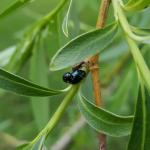 Imported Willow Leaf Beetle: Plagiodera versicolora adult beetles overwinter near susceptible hosts. Adult beetles will chew holes and notches in the leaves of willow once they become available. Females lay yellow eggs in clusters on the undersides of leaves. Larvae are slug-like and bluish-green in color. They will feed in clusters and skeletonize the leaves. Most plants can tolerate multiple years of feeding from this insect, and foliage will appear brown. Repeated yearly feeding can occasionally be an issue, in which case management of the young larvae may be necessary. Take care with treatment in areas near water.
Imported Willow Leaf Beetle: Plagiodera versicolora adult beetles overwinter near susceptible hosts. Adult beetles will chew holes and notches in the leaves of willow once they become available. Females lay yellow eggs in clusters on the undersides of leaves. Larvae are slug-like and bluish-green in color. They will feed in clusters and skeletonize the leaves. Most plants can tolerate multiple years of feeding from this insect, and foliage will appear brown. Repeated yearly feeding can occasionally be an issue, in which case management of the young larvae may be necessary. Take care with treatment in areas near water.
Check out Episode 4 of InsectXaminer to see the imported willow leaf beetle in action: https://ag.umass.edu/landscape/education-events/insectxaminer
-
Honeylocust Plant Bug: Diaphnocoris chlorionis feeding results in tiny yellowish-brownish spots on leaves, leaf distortion, and in some cases, defoliation. (There are at least 7 species of plant bugs that feed on honeylocust, Gleditsia triacanthos.) There is one generation per year. Immatures and adults feed on foliage and light to moderately damaged foliage may persist throughout the growing season. Honeylocust plant bugs overwinter as eggs laid just beneath the bark surface of 2- and 3-year-old twigs. Eggs hatch just after vegetative buds of the host begin to open. Young nymphs crawl to the opening leaflets and begin feeding and the most significant damage occurs at that time, when the insect is hidden from view. Nymphs develop into adults around May-July. This insect can be targeted between 58-246 GDD’s, base 50°F.
-
Lilac Borer: Podosesia syringae is a clearwing moth pest of lilac, privet, fringetree, and ash. (It is also known as the ash borer, not to be confused with the emerald ash borer.) Adults mimic paper wasps. Larvae are wood-boring, and signs and symptoms include branch dieback, holes, and occasionally, sawdust-like frass accumulated on bark. Larvae bore into stems, trunks, and branches, chewing an irregularly shaped entrance hole. Peak adult moth flights may occur in the northern portion of this insect’s range in June and are usually over by August 1st. Pheromone traps can be used to time adult emergence. Adult females lay flattened, oval, and tan eggs that are deposited singly or in clusters on bark crevices, ridges, and sometimes smooth bark; but usually laid in or near wounds in the bark. On average, 395 eggs are laid by each female. After hatch, larvae chew into the bark and feed laterally and then vertically in phloem tissue. Larvae overwinter in tunnels in the final instar and resume feeding in the spring. Adults emerge through a round exit hole (4-5 mm. in diameter). This insect may be targeted between 200-299 GDD’s, base 50°F.
-
Lecanium Scales (Oak): Parthenolecanium quercifex overwinters as a second instar nymph on oak twigs. Females will begin feeding and mature in the spring, from mid-April to early May and eggs may be laid between late May and into June. Eggs hatch in June or early July and crawlers migrate to host plant leaves where they spend the summer and migrate as second instars back to host plant twigs in the fall. Mid-April to early-May (35-145 GDD’s) for dormant oil applications.
-
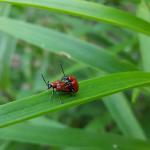 Lily Leaf Beetle: Lilioceris lilii adults overwinter in sheltered places. As soon as susceptible hosts such as Lilium spp. (Turk’s cap, tiger, Easter, Asiatic, and Oriental lilies) and Fritillaria spp. break through the ground, the adult lily leaf beetles are known to feed on the new foliage. (Note: daylilies are not hosts.) Typically, in May, mating will occur and each female will begin to lay 250-450 eggs in neat rows on the underside of the foliage. If there are only a few plants in the garden, hand picking and destroying overwintering adults can help reduce local garden-level populations at that time.
Lily Leaf Beetle: Lilioceris lilii adults overwinter in sheltered places. As soon as susceptible hosts such as Lilium spp. (Turk’s cap, tiger, Easter, Asiatic, and Oriental lilies) and Fritillaria spp. break through the ground, the adult lily leaf beetles are known to feed on the new foliage. (Note: daylilies are not hosts.) Typically, in May, mating will occur and each female will begin to lay 250-450 eggs in neat rows on the underside of the foliage. If there are only a few plants in the garden, hand picking and destroying overwintering adults can help reduce local garden-level populations at that time.
Check out Episode 3 of InsectXaminer to see the lily leaf beetle in action: https://ag.umass.edu/landscape/education-events/insectxaminer
-
Magnolia Scale: Neolecanium cornuparvum overwinters as first instar nymphs which are elliptical, and dark slate gray in color and can usually be found on the undersides of 1 and 2 year old twigs. Nymphs may molt by late April or May and again by early June at which time the scales may be purple in color. Eventually nymphs secrete a white powdery layer of wax over their bodies. Dormant oils can be applied between 7-35 GDD’s targeting the overwintering nymphs. Avoid applications to opening buds or blooms.
-
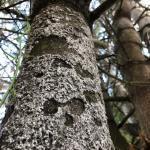 Pine Bark Adelgid: Pineus strobi overwinters as an immature which begins feeding during the first days of warm weather in the spring and begins secreting white wax over itself, which can eventually coat the entire trunk of infested trees. The white wax from pine bark adelgids was observed on eastern white pine in Amherst, MA on April 13, 2022. Egg laying may begin in April. This insect can be found on the trunk, branches, twigs, and the base of needles on new shoots. Spruce is a secondary host but this adelgid can repeatedly reproduce itself on pine. Wash off bark with a strong jet of water. If necessary, dormant oil applications can be made in mid-late April between 22-58 GDDs. Hosts include eastern white, Scots, and Austrian pines. This insect does little damage to healthy trees and can often be tolerated.
Pine Bark Adelgid: Pineus strobi overwinters as an immature which begins feeding during the first days of warm weather in the spring and begins secreting white wax over itself, which can eventually coat the entire trunk of infested trees. The white wax from pine bark adelgids was observed on eastern white pine in Amherst, MA on April 13, 2022. Egg laying may begin in April. This insect can be found on the trunk, branches, twigs, and the base of needles on new shoots. Spruce is a secondary host but this adelgid can repeatedly reproduce itself on pine. Wash off bark with a strong jet of water. If necessary, dormant oil applications can be made in mid-late April between 22-58 GDDs. Hosts include eastern white, Scots, and Austrian pines. This insect does little damage to healthy trees and can often be tolerated. -
Snowball Aphid: Neoceruraphis viburnicola eggs overwinter on viburnum twigs and buds. Eggs hatch and this aphid becomes active on certain species of viburnum roughly between 148-298 GDD’s or around redbud bloom. This insect is particularly noticeable on V. opulus, V. prunifolium, and V. acerifolia. Stem mothers, appearing blueish-white, can be found in curled up and distorted foliage. Damage caused by this insect pest is mostly aesthetic.
-
Spruce Bud Scale: Physokermes piceae is a pest of Alberta and Norway spruce, among others. Immatures overwinter on the undersides of spruce needles, dormant until late March. By April, females may move to twigs to complete the rest of their development. Dormant oil applications may be made between 22-121 GDDs. Follow all label instructions, as oil may remove the bluish color from certain conifers. Mature scales are reddish brown, globular, 3 mm. in diameter, and found in clusters of 3-8 at the base of new twig growth. They closely resemble buds and are often overlooked. Crawlers are present around June.
-
Spruce Spider Mite: Oligonychus ununguis is a cool-season mite that becomes active in the spring from tiny eggs that have overwintered on host plants. Hosts include spruce, arborvitae, juniper, hemlock, pine, Douglas-fir, and occasionally other conifers. This particular species becomes active in the spring and can feed, develop, and reproduce through roughly June. When hot, dry summer conditions begin, this spider mite will enter a summer-time dormant period (aestivation) until cooler temperatures return in the fall. This particular mite may prefer older needles to newer ones for food. When damaging spruce spider mite populations are known from last season, dormant oil applications can be made (when temperatures are appropriate according to label instructions) between 7-121 GDD’s, base 50°F (April). Magnification is required to view spruce spider mite eggs. Tapping host plant branches over white paper may be a useful tool when scouting for spider mite presence. (View with a hand lens.) Spider mite damage may appear on host plant needles as yellow stippling and occasionally fine silk webbing is visible. Be sure to also scout for predatory mite adults and eggs which can help regulate spruce spider mite populations. Avoid broad spectrum chemical management options that kill predatory mite populations, often making spruce spider mite outbreaks worse.
-
Viburnum Leaf Beetle: Pyrrhalta viburni is a beetle in the family Chrysomelidae that is native to Europe, but was found in Massachusetts in 2004. Viburnum leaf beetle overwinters as eggs laid in capped pits on the newest growth of susceptible viburnum branches. Scout for overwintered eggs and prune out and destroy before they hatch. Egg hatch occurs in late-April to early-May as temperatures warm and foliage becomes available. Monitor for larvae in mid-May (80-120 GDD’s). This beetle feeds exclusively on many different species of viburnum, which includes, but is not limited to, susceptible plants such as V. dentatum, V. nudum, V. opulus, V. propinquum, and V. rafinesquianum. Some viburnum have been observed to have varying levels of resistance to this insect, including but not limited to V. bodnantense, V. carlesii, V. davidii, V. plicatum, V. rhytidophyllum, V. setigerum, and V. sieboldii. More information about viburnum leaf beetle may be found at http://www.hort.cornell.edu/vlb/ .
-
White Pine Weevil: Pissodes strobi adults overwinter in sheltered locations in the leaf litter and become active very early in the spring, when daytime temperatures reach 50°F and before the bloom of forsythia (between 7-58 GDDs). Hosts include eastern white pine, Norway spruce, scotch, pitch, and red pine, blue spruce, and white spruce. Adults will begin feeding on bark 7-10 inches below dormant terminal buds. Females will deposit eggs in terminal growth bark, and developing larvae will feed in leaders until they mature in July when pupation occurs in pupal chambers made of wood chips. Management in nurseries or Christmas tree production may be necessary. Target adults between 7-58 GDD’s.
-
White Spotted Pine Sawyer (WSPS): Monochamus scutellatus adults can emerge in late May throughout July, depending on local temperatures. This is a native insect in Massachusetts and is usually not a pest. Larvae develop in weakened or recently dead conifers, particularly eastern white pine (Pinus strobus). However, the white spotted pine sawyer looks very similar to the invasive Asian Longhorned Beetle, Anoplophora glabripennis, ALB. ALB adults do not emerge in Massachusetts until July and August. Beginning in July, look for the key difference between WSPS and ALB adults, which is a white spot in the top center of the wing covers (the scutellum) on the back of the beetle. White spotted pine sawyer will have this white spot, whereas Asian longhorned beetle will not. Both insects can have other white spots on the rest of their wing covers; however, the difference in the color of the scutellum is a key characteristic. See the Asian longhorned beetle entry above for more information about that non-native insect.
-
Woolly Apple Aphid: Eriosoma lanigerum may be found on apple, crabapple, hawthorn, mountain-ash, Pyracantha, and elm hosts. The primary (winter) host is elm, on which aphids infest emerging spring leaves, causing leaves to curl or close into stunted, rosette-like clusters found at twig tips. On apple and crabapple, this species of aphid colonizes roots, trunks, and branches in the summer and is commonly found near previous wounds or callous tissue. On roots, the aphids cause swelled areas which can girdle and kill roots. The aphids, when found in above ground plant parts such as elm leaves, are covered with white wax. Eggs are the overwintering stage on elm, which hatch in the spring in time for the nymphs to infest new elm foliage. Following a few generations on elm, the aphids will develop into a winged form, which will disperse and seek out apple and crabapple. Multiple generations will occur on these alternate hosts in the summer and by the fall, a winged form will return to elm and mated females will lay eggs near elm buds. These aphids are a favorite snack for insect predators such as the multicolored Asian lady beetle, Harmonia axyridis. Elm can withstand multiple years of woolly apple aphid infestation and this insect is primarily aesthetic in its impact to trees. Management may not be necessary.
-
Woolly Elm Aphid: Eriosoma americanum females lay a single egg in the cracks and crevices of elm bark, where the egg overwinters. Eggs hatch on elm in the spring as leaves are unfolding. Aphids may be active from 121-246 GDD’s, base 50°F on elm. A young, wingless female hatched from the egg feeds on the underside of leaf tissue. This female aphid matures and gives birth to 200 young, all females, without mating. These aphids feed, and the elm leaf curls around them and protects them. By the end of June, winged migrants mature and find serviceberry hosts. Another set of females is produced. These new females crawl to and begin feeding on the roots of serviceberry. Multiple generations occur on the roots of serviceberry through the summer. Elm can withstand multiple years of woolly elm aphid infestation and this insect is primarily aesthetic in its impact to trees. Management may not be necessary. Lady beetle larvae and adults often feed on these insects.
Concerned that you may have found an invasive insect or suspicious damage caused by one? Need to report a pest sighting? If so, please visit the Massachusetts Introduced Pests Outreach Project: http://massnrc.org/pests/pestreports.htm .
Reported by Tawny Simisky, Extension Entomologist, UMass Extension Landscape, Nursery, & Urban Forestry Program
Landscape Practices
Shrub of the week: Amelanchier spp., Serviceberry
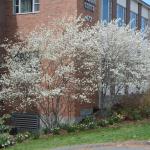
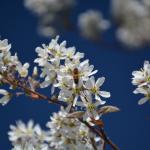
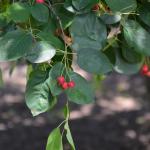
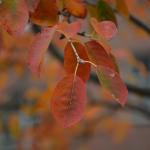 Serviceberry are a large shrub or small tree offering multiple seasons of interest. Many members of the genus are native to eastern North America including Amelanchier canadensis, A. arborea, and A. laevis. Terminal clusters of five-petaled white flowers appear in spring (April). Unfortunately, flowers are short-lived, lasting only about one week. Leaves emerge after flowering, are medium to dark green in summer, and change to shades of orange and red in fall. Flowers give way to small pommes that change from green to red to purple-black as they ripen. Plants vary in size depending on species but generally range from 15-30’ tall and wide. Amelanchier do not have serious insect or disease problems. They do best in full sun to part shade in well-drained, average soil. They can be used as a specimen, in the shrub border, or in woodland gardens. Berries attract birds and are also edible, often used in jams and jellies.
Serviceberry are a large shrub or small tree offering multiple seasons of interest. Many members of the genus are native to eastern North America including Amelanchier canadensis, A. arborea, and A. laevis. Terminal clusters of five-petaled white flowers appear in spring (April). Unfortunately, flowers are short-lived, lasting only about one week. Leaves emerge after flowering, are medium to dark green in summer, and change to shades of orange and red in fall. Flowers give way to small pommes that change from green to red to purple-black as they ripen. Plants vary in size depending on species but generally range from 15-30’ tall and wide. Amelanchier do not have serious insect or disease problems. They do best in full sun to part shade in well-drained, average soil. They can be used as a specimen, in the shrub border, or in woodland gardens. Berries attract birds and are also edible, often used in jams and jellies.
Report by Mandy Bayer, Extension Assistant Professor of Sustainable Landscape Horticulture, UMass Stockbridge School of Agriculture
Additional Resources
Pesticide License Exams - The MA Dept. of Agricultural Resources (MDAR) is now holding exams online. For more information and how to register, go to: https://www.mass.gov/pesticide-examination-and-licensing.
To receive immediate notification when the next Landscape Message update is posted, join our e-mail list or follow us on Facebook.
For a complete listing of upcoming events, see our upcoming educational events https://ag.umass.edu/landscape/upcoming-events
For commercial growers of greenhouse crops and flowers - Check out UMass Extension's Greenhouse Update website
For professional turf managers - Check out Turf Management Updates
For home gardeners and garden retailers - Check out our home lawn and garden resources.
Diagnostic Services
UMass Laboratory Diagnoses Landscape and Turf Problems - The UMass Extension Plant Diagnostic Lab is available to serve commercial landscape contractors, turf managers, arborists, nurseries and other green industry professionals. It provides woody plant and turf disease analysis, woody plant and turf insect identification, turfgrass identification, weed identification, and offers a report of pest management strategies that are research based, economically sound and environmentally appropriate for the situation. Accurate diagnosis for a turf or landscape problem can often eliminate or reduce the need for pesticide use. For sampling procedures, detailed submission instructions and a list of fees, see Plant Diagnostic Laboratory
Soil and Plant Nutrient Testing - The University of Massachusetts Soil and Plant Nutrient Testing Laboratory is located on the campus of The University of Massachusetts at Amherst. Testing services are available to all. The lab provides test results and recommendations that lead to the wise and economical use of soils and soil amendments. For more information, including current turn-around times, visit the UMass Soil and Plant Nutrient Testing Laboratory web site. The lab is currently accepting new orders for Routine Soil Analysis (including optional Organic Matter, Soluble Salts, and Nitrate testing), Particle Size Analysis, Pre-Sidedress Nitrate (PSNT), and Soilless Media (no other types of soil analyses available at this time). Turnaround time: Please plan for the fact that date of receipt in the lab is affected by weekends, holidays, shipping time, and time for UMass Campus Mail to deliver samples to the lab.
Tick Testing - The UMass Center for Agriculture, Food, and the Environment provides a list of potential tick identification and testing options at: https://ag.umass.edu/resources/tick-testing-resources.
Acknowledgements: UMass Extension gratefully acknowledges the support of the following funding sources for the production of the Landscape Message –
- The Massachusetts Nursery and Landscape Association Fund
- The Massachusetts Department of Conservation and Recreation, Award #ISADCR28219926UMA22A
- Stakeholders like you! The Landscape Message is partially supported by educational program user fees.